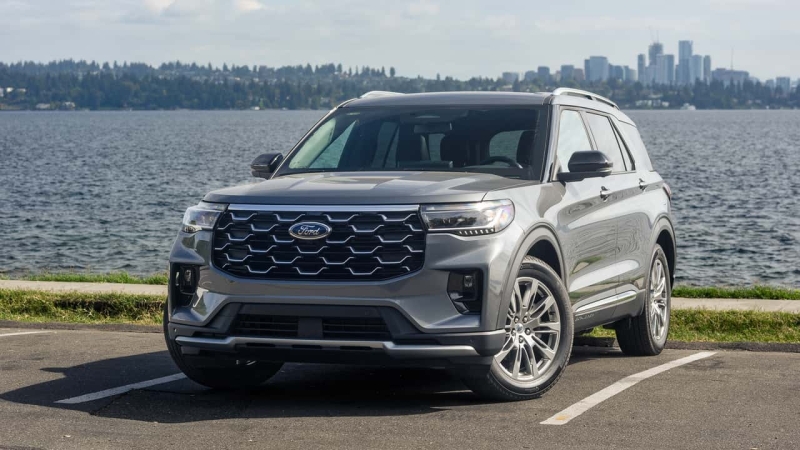The 2025 Explorer is markedly improved—but it looks so angry for an SUV that drives so relaxed.
Victoria Scott / Motor1
The 2025 Ford Explorer has a friendlier infotainment system, a slicker interior, and a laundry list of features—including Ford’s fantastic BlueCruise Level 2 driving assist. Unfortunately, it also gets much angrier-looking, and its top-trim Platinum and ST models are pricey enough to make for some confusing cross-shopping for three-row buyers.
| Quick Specs | 2025 Ford Explorer Platinum |
| Engine | Turbocharged 2.3-Liter Inline-Four |
| Output | 300 Horsepower / 310 Pound-Feet |
| Efficiency | 20 City / 29 Highway / 24 Combined |
| Base Price/As Tested | $41,350 / $53,250 |
| On-Sale Date | Now |
I’ll start with its physical appearance. When my test vehicle was dropped off, I initially saw it from the rear. It’s actually handsome from that angle, with taut character lines running into the new heckeblende-style taillights; It’s not a huge leap over the outgoing model, but it’s still attractive. Then I walked around to the front, and I will not mince words: The Platinum trim’s chrome-clad new grille looks like a cheese grater with malicious intent.
The front-end design is unfriendly and doesn’t flow neatly to those side-panel character lines. The sole upside of this gaping maw is that it will be easier to spot coming up from behind when sold in Police Interceptor guise, I suppose. For an SUV that until recently has dodged the road-rage stylistic trends, it’s just disappointing to see it get so angry.
Inside, luckily, the new Explorer looks much better. Ford dumped the vertically oriented center touchscreen and dated-looking Sync 3 infotainment system for a traditional, horizontally oriented screen and what it calls the “Ford Digital Experience,” an Android Automotive-based software package. It integrates natively with Google’s automotive app store and offers both Amazon Alexa and Google Assistant for voice commands. It also adds wireless Apple CarPlay functionality.
Inside, luckily, the new Explorer looks much better. Ford dumped the vertically oriented center touchscreen and dated-looking Sync 3 infotainment system for a traditional, horizontally oriented screen and what it calls the “Ford Digital Experience,” an Android Automotive-based software package. It integrates natively with Google’s automotive app store and offers both Amazon Alexa and Google Assistant for voice commands. It also adds wireless Apple CarPlay functionality.
The Ford Digital Experience is a huge leap over the outgoing system both in form and function, with modernized looks and rapid response times. It does a lot to make the cabin feel becoming of a mid-20s machine, and for 2025, the Explorer’s infotainment goes from a sticking point to a selling point.
The cabin is also massive, with 62.1 inches of front shoulder room, 38.9 inches of headroom (even with the Platinum’s massive two-row glass panel/moonroof equipped), and 16.3 cubic feet of cargo space with all three rows up. With the third row flat (a single button-press operation in the Platinum), the 46.0 cubic feet of total space was enough for three weeks’ worth of groceries for a couple, with a few full-size suitcases’ worth of room to spare. Some competitors (such as the Honda Pilot) are a bit larger on paper, but the Explorer felt easy to load, so I doubt buyers would notice the extra cubic foot or two.
The rest of the interior is satisfactory, although unadorned. The dash in my Platinum-trim example is tied together with a soundbar-like material (into which some of the 14 Bang & Olufsen speakers are integrated) as well as a textured black-wood-esque piece of trim. Leather is relegated to the lower dash and the door panel armrests. It feels fine for an Explorer.
The Platinum RWD model I sampled clocks in at $53,250. But for a top-spec all-wheel-drive ST model, prices can top $58,000. That’s a bit much for an SUV that gets so close in price to, say, a Lexus TX (which starts at $55,050).
But the Explorer Platinum’s biggest draw for 2025 isn’t its styling or its interior at all—it’s the optional BlueCruise system that most new Explorers can be outfitted with. I was headed to Portland for a work event, which gave me ample time to test the hands-free Level 2 system. It functioned excellently at higher speeds, worked when I wore sunglasses, and handled stop-and-go traffic very well. It did require intervention in tighter corners, and at mid-speed heavy traffic (around 40 mph average) it felt like it could be a bit sudden on the brakes. It was truly hands-free, but I found my hands hovering very closely during these traffic slowdowns.
The 12.3-inch digital cluster bears most of the blame for my shaky confidence. While there is a driving-assistance visualization mode, it relayed no information to me about what conditions the SUV could “see” aside from whether there was a car, somewhere, in front of me. It made it hard to relax as I watched the Ford get closer to traffic, uncertain what it was detecting. It does err on the side of safety during automatic lane changes, which was comforting. The driver-monitoring software is also aggressive, which is good; The few times I’d get absentmindedly lost looking at the scenery, the Explorer would alert me to look back at the road.
Still, BlueCruise isn’t cheap. My test vehicle had a 90-day trial, but after that, it’s $49.99 a month or $495 a year. A $2,495 one-time purchase is available, which Ford states will cover a minimum of seven years. BlueCruise coverage is decent, available on 130,000 miles of roadway, but it still lags far behind GM’s SuperCruise, which covers 750,000 miles (and is now available on the direct-competitor Chevrolet Traverse). Major interstates will be fine but expect to drive yourself everywhere else.
Driving yourself is at least pleasant. The turbocharged 2.3-liter four-cylinder engine makes 300 horsepower (significantly more powerful than many gas-only competitors, like the 265-horsepower Toyota Grand Highlander), which was plenty for quick merges. Even the base motor has a max 5,000-pound towing capacity, as well. The 10-speed is usually decisive, although sometimes it hesitated to drop enough gears when I needed to make a quick pass.
The turbo motor’s noise and vibration peaked when high in the rev range, but otherwise felt smooth and sounded quiet. Steering verges on the overboosted side, but it’s easy to adapt to and sharp enough on-center. The body doesn’t roll sloppily in corners, and the brakes are even and predictable. I consistently returned better than EPA-rated average figures, as well. Relaxed, fuel-sipping drivers will find it satisfactory; Those with a lead foot may want a little more engagement like in a Mazda CX-90, however.
But on a blitz down the 5 for three hours, I didn’t have a lead foot. BlueCruise handled 90% of the journey and I put the seat massagers on. I let a podcast play on the Bang & Olufsen sound system and kept my hands in my lap. If that sounds like a good day at the wheel, the Explorer is a perfect fit. Just prepare to be startled when you see its face in your garage.
Competitors
- Chevrolet Traverse
- Honda Pilot
- Kia Telluride
- Mazda CX-90
- Toyota Grand Highlander
Get the best news, reviews, columns, and more delivered straight to your inbox, daily. Sign up For more information, read our
Privacy Policy and Terms of Use.
2025 Ford Explorer Platinum
Engine Turbocharged 2.3-Liter Inline Four
Output 300 Horsepower / 310 Pound-Feet
Transmission 10-Speed Automatic
Drive Type Rear-Wheel Drive
Speed 0-60 MPH 7.0 Seconds (Est.)
Weight 4,344 Pounds
Efficiency 20 City / 29 Highway / 24 Combined
Seating Capacity 6
Towing 5,000 Pounds
Cargo Volume 16.3 Cubic Feet / 46.0 Cubic Feet / 85.3 Cubic Feet
Base Price $41,350
As-Tested Price $53,250
On Sale Now



